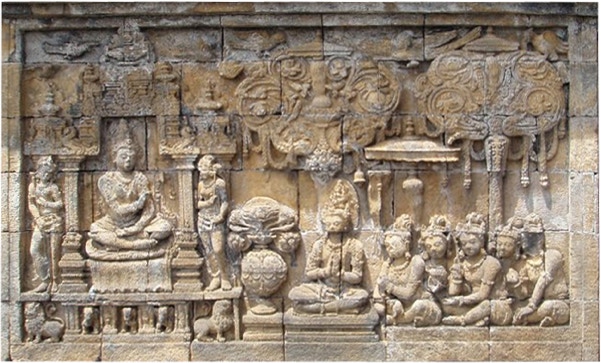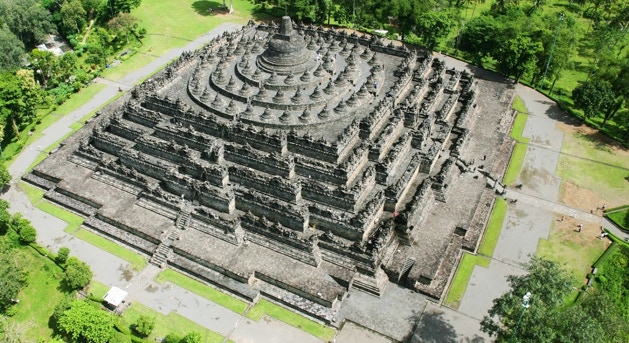V. BOROBUDUR:
Mountain, Mandala, Monument
BOROBUDUR, JAVA (770 - 830)
SUDHANA LISTENING TO ONE OF THIS "52 FRIENDS," BOROBUDUR (770 - 830)

The liturgical advantages of linear addition for temple design does not fully explain why, despite the paramount importance Indian architects attached to the concept of the “temple mountain” and their genius for finding ever more ingenious forms with which to express it, they do not appear to have attempted to build a pyramid in stone. Mountains, specifically the Himalayas, had long been seen as the haunt of the Hindu deities and the furthest reach from pedestrian, dust-bound humanity. The Khmer built temples on every mountain, or what passed for one, in their water-logged homeland and, where there were no hillocks, they erected mountains of masonry. Nor were they alone; one need not hypothesize improbable trans-continental “cultural transmission” to account for the appearance of pyramids as thresholds to the divine around the globe – but not in India. In the absence of the arch and steel girder, heaping mounds of earth and rubble or laying diminishing courses of stones were the only practical means for making a man-made, imitation mountain of sufficient breadth and height to be convincing. The earliest “temple mountain” was probably the Step Pyramid of Djoser at Saqqara (2667 - 2648 B.C.E.,) followed by the “ziggurats” of Mesopotamia, a name meaning “to build a raised place” in Akkadian. The 14th Century B.C.E Babylonian Dur Kurigaizu may possibly have been the original “Tower of Babel,” to the conquered Hebrews a symbol of pagan hubris competing with their monotheistic, unnamable god. In Mesoamerica, isolated from the Eastern Hemisphere for millennia, the largest, if no longer most impressive temple mountain, was built at Cholula near Puebla, in the 9th Century, the aptly named Tlachihualtepetl, “the mountain built by hand” in Nahuatl, all 4.45 million cubic meters of it, now a grassy hill crowned by a Christian church.
Did Indian sthapakas disdain a mass of masonry as too literal an interpretation of what was at best a metaphor with many possible metaphysical tenors? Or was their anti-materialistic theology offended by the notion of making an imitation mountain – an illusion of an illusion – preferring an obvious “aedicule” or icon of a mountain, thus emphasizing that a temple, a mountain and Mt. Meru were merely “dependently-originated” emanations and mirages which would be destroyed, like their creator, Brahma, every 311 trillion 40 billion years ––just a “flash in eternity” in the words of the Bhagavad Gita. Still, it comes as a surprise that the first, great “temple mountain” in the Indic cultural ambit was built at a remote inland site surrounded by volcanoes on the Kedu Plain of South Java, 40km from present-day Yogyakarta. The temple mountain of Borobudur is estimated to have taken sixty years, from 770 to 830, to complete during the peak of the Mahayana Buddhist Sailendra Kingdom. Jayavarman II (790 - 835) may have been a feudatory of the Sailendras and even have spent time in Java before he declared the independence of the Khmer Empire in 802, while the temple was still under construction.
Perhaps as surprising as Borobudur’s location is that this first “temple mountain” achieved a level of architectural and theological sophistication never again equaled or attempted. The temple appears not only to have been laid-out according to a mandala, like those of India, but to have functioned as one as well, a yantra, a diagram or device for “consciousness raising,” here a literal pathway for attaining “enlightenment in this life-time” – or at least simulating its path over a weekend. Mandalas are intended to aid their makers’ meditations and visualizations and then destroyed once their outward, illusory form had been internalized; hence, they have always been regarded as ephemeral, painted on perishable fabric or even drawn in sand. At Borobudur, however, groups of pilgrims were presumably intended in the coming centuries to make their way around the padas of each of mandala’s concentric squares, upward and inward along a 3km long “liturgical path,” towards its central stupa and tip, the primal bindu or dot, literally climbing towards satori stone by stone and footstep by footstep. (Figure 10 on the following page is a detailed diagram of Borobudur showing the positioning of the 504 Buddhas on its four square side and circular top, as well as, the location of the Buddhist texts illustrated on the bas relief panels carved on the balustrades and walls of its terraces.]
Upwards of 3500 mandalas are recorded from the 9th Century and although scholars have been unable to find one which corresponds exactly with Borobudur’s site plan, its similarities with several widely-used types are striking. For example, the 504 Buddha statues which line its terraces are aligned in accord with the Diamond World Mandala, one of the most widely used Tantric models. The 368 statues in the niches above the first four terraces sign with the mudra of the four Mahayana dhyani, tathagata or “wisdom” Buddhas, associated with the direction they face; the 72 Buddhas in the dagobas or stupas of the three round terraces (gold circles) have been associated with Vairocana, the central Buddha of that mandala of whom the other four are aspects or manifestations.
The identity of the 64 Buddhas on the 5th terrace (dark green) has occasioned considerable scholarly debate because 1) the Diamond World mandala has only five Buddhas and 2) the 64 statues are depicted in vitarka or teaching mudra, not used in that mandala. Some have speculated that the Buddhas of the 5th terrace and in the stupas are both Vairocana, while others have suggested the “extra,” “sixth” Buddha is the historical Buddha, born Siddhartha Gautama. A third group has put forward Vajradhara, a Buddha found especially in Vajrayana or Tantric sutras, the Adi-Buddha or source of the other five, representing the dharmakhana, the non-manifest or “subtle” “Buddha body,” “nature” or “essence,” equivalent to ultimate reality, sunyata or emptiness of thought and substance. Thus, Borobudur still withholds some of its secrets despite the great advances of modern research. All the Buddhas, significantly, face outward towards the world in keeping with the temple’s primarily didactic mission.
The texts illustrated on Borobudur’s 2670 bas relief panels (1460 of them narrative, the rest decorative) in two registers on the walls and balustrades of its four concentric, redented terraces seem deliberately selected and sequenced to illustrate the three dhatus, lokas or “realms” of Buddhist cosmology, subdivided into thirty-three (or thereabout,) ranked levels of consciousness, (see appendix I, “Buddhist Cosmology.”) The original base, (now hidden by a “false foot,” added when the temple began to subside under its own massive weight,) the 1st terrace and the balustrade of the 2nd, depict events from the kamadhatu, the ten “desire worlds” inhabited by humans as well as the Vedic gods and demons. The panels on the three upper terraces are taken from the Gandavyuha, (The Structure of the World Compared to a Bubble or The Entrance into the Dharma) which constitutes the 39th chapter of the Flower Ornament Sutra and its sequel, the Bhadraari Sutra. These are important, if obscure, Mahayana texts describing the quest for enlightenment of a youth, Sudhana, in the course of which he is instructed by no fewer than fifty-two “good friends,” gurus, bodhisattvas and Buddhas, populating the rupadhatu, the eighteen “form worlds” of those who are no longer subject to cataleptic desires, experiencing only self-delight, but still occupy discrete territory in space and a unified consciousness capable of instructing others. On the fifth terrace bas reliefs are replaced by Buddhas in lattice-work stupas or dagobas, some with square, some with hexagonal matrices, which presumably represent the arupadhatu, the four “formless worlds” of beings who have transcended individual form and spatial dimension; since they therefore cannot be represented, they are bracketed in a kind of “architectural parenthesis” or "under erasure," partially visible within the dagobas as Buddhas withdrawn in meditating on the emptiness of their own meditations.
